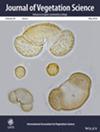Contrasting Species Richness in Patches of Alternative Foundation Species Suggests a Framework for Understanding Species of Unusual Effect
Abstract
Questions
Structurally dominant species can be especially influential in plant community assembly and ecosystem function as Species of Unusual Effect (SUEs). For example, indigenous bunchgrasses function as foundation species and ecosystem engineers in the naturally high-diversity groundcover of longleaf pine savannas. Other species structurally dominate relatively small, discrete patches across the savanna landscape, for example, the fern Pteridium aquilinum and the shrub Ilex glabra. Do patch-level species richness or composition of assemblages of groundcover plants, or of arthropods, differ between bunchgrass-dominated groundcover and groundcover dominated by P. aquilinum or I. glabra?
Location
We conducted our study in a restored longleaf pine savanna in southeastern Louisiana.
Methods
We compared the groundcover plant and arthropod assemblages within discrete patches structurally dominated by P. aquilinum or I. glabra to adjacent areas dominated by indigenous bunchgrasses. We compared local plant species richness and composition, stem density, aboveground dry biomass, and litter dry biomass, as well as arthropod species richness and composition, abundance, and dry biomass.
Results
Species richness and stem density of nondominant groundcover plants were significantly lower in patches of P. aquilinum and I. glabra than within bunchgrass-dominated areas. Species composition of nondominant groundcover plants was more variable within I. glabra patches compared to bunchgrass areas. Arthropod species richness and abundance were also significantly lower in patches of P. aquilinum compared to bunchgrass areas, and species composition of arthropods differed significantly between P. aquilinum patches and bunchgrass areas.
Conclusions
At the local scale of groundcover plant patches—along with their attendant arthropods—indigenous bunchgrasses are associated with higher species richness compared to either of the alternative foundation species P. aquilinum or I. glabra. Removal experiments, community-assembly experiments, or reciprocal replacement experiments should be conducted to test the hypothesis that these species differentially influence the groundcover as, respectively, diversity-enhancing versus diversity-inhibiting SUEs. Our observations exemplify how alternative foundation species could add complexity to natural landscapes by differentially influencing characteristics of their associated local communities.


 求助内容:
求助内容: 应助结果提醒方式:
应助结果提醒方式:


